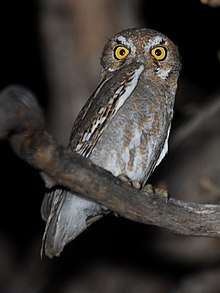Elf owl: Difference between revisions
Uncle Dick (talk | contribs) m Reverted edits by 165.139.160.121 to last revision by 74.101.144.120 (HG) |
→Reproducing: Cleared up the language slightly |
||
| Line 20: | Line 20: | ||
The '''Elf Owl''' (''Micrathene whitneyi'') is a member of the [[owl]] [[family (biology)|family]] [[Typical owl|Strigidae]] that breeds in the [[southwestern United States]] and [[Mexico]]. It is the world's smallest owl, followed closely by the [[Pygmy owl]].{{Facts|date=January 2009}} They are 5-12 inches tall and have a wingspan of 15-16 inches and short tails. Their primary projection extends nearly past their tail. They have fairly long legs and often appear bow-legged. They are 1-1.4 ounces.They can often be heard just after dusk or at sunset, calling to each other. Their call is a high pitched whinny or chuckle. The male and female dart around the trees and call back and forth. |
The '''Elf Owl''' (''Micrathene whitneyi'') is a member of the [[owl]] [[family (biology)|family]] [[Typical owl|Strigidae]] that breeds in the [[southwestern United States]] and [[Mexico]]. It is the world's smallest owl, followed closely by the [[Pygmy owl]].{{Facts|date=January 2009}} They are 5-12 inches tall and have a wingspan of 15-16 inches and short tails. Their primary projection extends nearly past their tail. They have fairly long legs and often appear bow-legged. They are 1-1.4 ounces.They can often be heard just after dusk or at sunset, calling to each other. Their call is a high pitched whinny or chuckle. The male and female dart around the trees and call back and forth. |
||
== |
==Reproduction== |
||
Elf Owls usually choose an abandoned [[woodpecker]] cavity, where the female lays three round white eggs. The eggs are incubated for about 3 weeks before the chicks hatch. The young owlets fledge at about 10 weeks. Usually, chicks are born in mid-June or early July. By the end of July, they are almost always fledged and ready to set out on their own. |
|||
==Behavior== |
==Behavior== |
||
Revision as of 21:02, 11 February 2010
| Elf owl | |
|---|---|

| |
| An Elf Owl in Arizona | |
| Scientific classification | |
| Kingdom: | |
| Phylum: | |
| Class: | |
| Order: | |
| Family: | |
| Genus: | Micrathene Coues, 1866
|
| Species: | M. whitneyi
|
| Binomial name | |
| Micrathene whitneyi (Cooper, 1861)
| |
The Elf Owl (Micrathene whitneyi) is a member of the owl family Strigidae that breeds in the southwestern United States and Mexico. It is the world's smallest owl, followed closely by the Pygmy owl.[citation needed] They are 5-12 inches tall and have a wingspan of 15-16 inches and short tails. Their primary projection extends nearly past their tail. They have fairly long legs and often appear bow-legged. They are 1-1.4 ounces.They can often be heard just after dusk or at sunset, calling to each other. Their call is a high pitched whinny or chuckle. The male and female dart around the trees and call back and forth.
Reproduction
Elf Owls usually choose an abandoned woodpecker cavity, where the female lays three round white eggs. The eggs are incubated for about 3 weeks before the chicks hatch. The young owlets fledge at about 10 weeks. Usually, chicks are born in mid-June or early July. By the end of July, they are almost always fledged and ready to set out on their own.
Behavior
They raise their young in north-facing woodpecker cavities in Saguaro cacti[2], sycamores, cottonwoods and other hardwood trees. They are often found in chapparal habitat, and are easily found during their breeding season.
Migrating
The elf owl migrates to Arizona and New Mexico in the spring and summer and in the winter it is found in central and southern Mexico.Migrant Elf Owls return north in mid-August or early May.
Diet
Elf Owls feed mainly on insects and therefore occupy habitats with a ready supply of these. Agaves and ocotillos are ideal places for foraging as moths and other insects may sleep in their flowers. Elf owls are known to eat scorpions, somehow managing to cut off the stinger. They are often seen chasing after flying insects, with a flight similar to a tyrant flycatcher's just after dusk.
Subspecies
M. w. idonea, the subspecies in southernmost Texas to central Mexico is resident, as are the isolated M. w. sanfordi of southernmost Baja California and M. w. graysoni of Socorro Island, south-west from the tip of Baja California. That species later apparently became extinct in the 20th century, probably around 1970.
References
- ^ Template:IUCN2006 Database entry includes justification for why this species is of least concern
- ^ Hardy, P., Morisson, M. (2001) The Wilson Bulletin 113(1)pp:23-32
- "National Geographic" Field Guide to the Birds of North America ISBN 0-7922-6877-6
- Handbook of the Birds of the World Vol 5, Josep del Hoyo editor, ISBN 84-87334-25-3
- "National Audubon Society" The Sibley Guide to Birds, by David Allen Sibley, ISBN 0-679-45122-6
External links
- Elf Owl photo-High Res, & Article fireflyforest.net
- Elf Owl photo gallery VIREO
- Elf Owl Photographs South Dakota Birds and Birding

